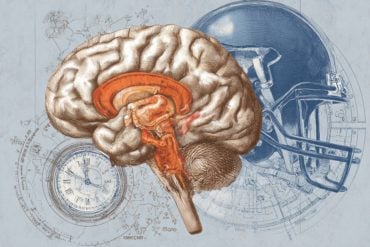Summary: Researchers report within the first weeks of life, deaf cats have reduced connections between the anterior ectosylvian sulcus and the superior colliculus. However, deaf cats have increased connections from other auditory areas to the superior colliculus.
Source: SfN.
Cats deaf from an early age have increased outgoing connections from the auditory cortex to a midbrain region responsible for directing the animal to a particular location in its environment. The study, published in Journal of Neuroscience, is the first to examine the reorganization of outputs from the sensory cortex following hearing loss.
Although mammals are able to see and hear early in life, the neural machinery that supports these senses develops slowly in response to input from the outside world. Such experience-dependent plasticity helps to fine-tune the animal’s perceptual abilities to its environment.
Without this input, the brain regions that would normally process the deprived sense are instead recruited for other purposes.
Compared to hearing cats, Blake Butler and colleagues found that cats made deaf in the first weeks of life had reduced connections from the anterior ectosylvian sulcus of the sensory cortex to the superior colliculus (SC) of the midbrain. However, the deaf cats had greater connections from other auditory areas to the SC, resulting in an overall larger input.

Connections from limbic brain regions to the SC were also increased in deaf cats, which may support enhanced information processing to complement the intact senses.
Funding: This work was supported by the Natural Sciences and Engineering Research Council of Canada, Canadian Institutes of Health Research, Canada Foundation for Innovation.
Source: David Barnstone – SfN
Publisher: Organized by NeuroscienceNews.com.
Image Source: NeuroscienceNews.com image is credited to Butler, Sunstrum & Lomber, JNeurosci (2018).
Original Research: Abstract for “Modified origins of cortical projections to the superior colliculus in the deaf: Dispersion of auditory efferents” by Blake E. Butler, Julia K. Sunstrum and Stephen G. Lomber in Journal of Neuroscience. Published April 2 2018.
doi:10.1523/JNEUROSCI.2858-17.2018
[cbtabs][cbtab title=”MLA”]SfN “Reorganization of Brain Outputs in Deaf Cats.” NeuroscienceNews. NeuroscienceNews, 1 April 2018.
<https://neurosciencenews.com/deaf-cat-brain-reorganization-8719/>.[/cbtab][cbtab title=”APA”]SfN (2018, April 1). Reorganization of Brain Outputs in Deaf Cats. NeuroscienceNews. Retrieved April 1, 2018 from https://neurosciencenews.com/deaf-cat-brain-reorganization-8719/[/cbtab][cbtab title=”Chicago”]SfN “Reorganization of Brain Outputs in Deaf Cats.” https://neurosciencenews.com/deaf-cat-brain-reorganization-8719/ (accessed April 1, 2018).[/cbtab][/cbtabs]
Abstract
Modified origins of cortical projections to the superior colliculus in the deaf: Dispersion of auditory efferents
Following the loss of a sensory modality, such as deafness or blindness, crossmodal plasticity is commonly identified in regions of the cerebrum that normally process the deprived modality. It has been hypothesized that significant changes in the patterns of cortical afferent and efferent projections may underlie these functional crossmodal changes. However, studies of thalamocortical and cortico-cortical connections have refuted this hypothesis, instead revealing a profound resilience of cortical afferent projections following deafness and blindness. This report is the first study of cortical outputs following sensory deprivation, characterizing cortical projections to the superior colliculus (SC) in mature cats (N=5, 3 female) with perinatal-onset deafness. The superior colliculus was exposed to a retrograde pathway tracer, and subsequently labeled cells throughout the cerebrum were identified and quantified. Overall, the percentage of cortical projections arising from auditory cortex was substantially increased, not decreased, in early-deaf cats when compared to intact animals. Furthermore, the distribution of labeled cortical neurons was no longer localized to a particular cortical subregion of auditory cortex, but dispersed across auditory cortical regions. Collectively, these results demonstrate that although patterns of cortical afferents are stable following perinatal deafness, the patterns of cortical efferents to the superior colliculus are highly mutable.
SIGNIFICANCE STATEMENT
When a sense is lost, the remaining senses are functionally enhanced through compensatory crossmodal plasticity. In deafness, brain regions that normally process sound contribute to enhanced visual and somatosensory perception. We demonstrate that hearing loss alters connectivity between sensory cortex and the superior colliculus — a midbrain region that integrates sensory representations to guide orientation behavior. Contrasting expectation, the proportion of projections from auditory cortex increased in deaf animals compared to normal hearing, with a broad distribution across auditory fields. This is the first description of changes in cortical efferents following sensory loss, and provides support for models predicting an inability to form a coherent, multisensory perception of the environment following periods of abnormal development.






